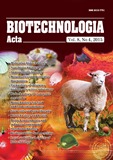ISSN 2410-7751 (Print)
ISSN 2410-776X (Online)

"Biotechnologia Acta" V. 8, No 4, 2015
https://doi.org/10.15407/biotech8.04.063
Р. 63-70, Bibliography 15, English
Universal Decimal Classification: 577.16:614.876
1Palladin Institute of Biochemistry of the National Academy of Sciences of Ukraine, Kyiv
2Chebotarev Institute of Gerontology of Academy of Medical Sciences of Ukraine, Kyiv
The aim of the research was to test the ability of the drug "Metovitan" to prevent the redox balance disturbance in the tissues and thiamine diphosphate irreversible oxidation upon exposure of ionizing radiation on the body. The rats were subjected to a single exposure of the X-ray therapeutic instrument RUM-17 to create a dose of 0.5, 1.0 and 5.0 Gray. Preparation "Metovitan" was administered at a dose of 25 mg per 1 kg body weight for 22–24 h before irradiation. Contents of thiamine diphosphate, reduced SH-groups and reactive oxygen species in blood and brain were determined using previously described methods. It has been shown that the active form of the thiamine diphosphate content in the blood was decreased depending on the doses (from 0.5 to 5.0 Gray). At the same time the content of thiamine diphosphate oxidized form was increased. Furthermore the critical changes occurred in metabolic processes redox state parameters, namely, the level of free SH-groups was reduced and the level of reactive oxygen species was increased. Similar changes were observed in the brain tissue.
The Metovitan single administration to the animals the day before irradiation, at 25 mg per 1 kg of body weight dose, promotes the protection of the intracellular thiamine diphosphate and redox status in animal tissues (blood, brain tissue) from the negative influence of irradiation (at 0.5; 1.0 Gray doses). These results give reason to recommend the drug for treating of the staff that is involved in the elimination of radioactive contamination. To provide the protection from the higher doses, other scheme of the treatment should be probably recommended.
Key words: thiamine diphosphate, reactive oxygen species, effects of ionizing radiation, Metovitan.
© Інститут біохімії ім. О. В. Палладіна НАН України, 2015
References
1. SpirichevV. B., DonchenkoG. V., Blazhee vichN. V., Parkhomenko Iu. M., Ale?nik S. I., Golubkina N. A., Vrzhesinskaia O. A., Isaeva V. A., Kodentsova V. M., Pereverzeva O. G., Sokol’nikov A. E., Iakushina L. M. To the 20th anniversary of the Chornobyl accident study of vitamin status and provision with microand macroelements of limited groups of people at different time periods since the accident at Chornobyl nuclear power plant. Ukr. Biokhim. Zh. 2006, 78 (2), 5–26. Review. (In Russian).
2. Parkhomenko Iu. M., Stepuro I. I., Donchenko G. V., Stepuro V. I. Oxidized derivatives of thiamine: formation, properties, biological role. Ukr. Biokhim. Zh. 2012, Nov-Dec, 84 (6), 5–24. (In Russian).
3. Rakici S. Y., Erdemli S. D., Yazici Z. A., Cengiz E, Acar O. G., Tufan G. Wernicke’s encephalopathy in a patient with unresectable gastric carcinoma and literature review. Int. J. Clin. Exp. Med. 2015, Jan 15, 8 (1),1453–1459. eCollection 2015.
4. Konopacka M., Rogolinski J. Thiamine prevents X-ray induction of genetic changes in human lymphocytes in vitro. Acta Biochim. Pol. 2004, 51 (3), 839–843.
5. Parkhomenko Yu. M., Chernysh I. Y u., Protasova Z. S., Donchenko G. V. A disturbance in thiamine metabolism in blood of patients with radial pathology and possible connection of this disturbance with the lesion of the nervous system. DAN Ukrainу. 1995, V. 2, P. 112–114. (In Ukrainian).
6. Donchenko G. V., Parkhomenko Yu. M., Protsova Z. S., Kovalenko V. M., Danevich O. I., Kohakina I. P., Chernysh I. Yu., Fedoseeva-Borodina L. O. Preparation for the increase of viability of organism. Patent of Ukraine N 39228 from 15.06. 2001, Biul. N5. 15.06. 2001.
7. Shtutman C. M., Sukharevskaya A. M. Vitamin E, selenium and sulfur-containing amino acids.
Chagovec R. V. Vitamins. Kyiv: Naukova dumka. 1975, P. 87–95. (In Russian).
8. Anisimova S. I., Donchenko H. V., Parkhomenko Iu. M., Kovalenko V. M. Mechanism of hepatoprotective action of methionine and composition “Metovitan” against a background of antituberculosis drug administration to rats. Ukr. Biokhim. Zh. 2013, 85 (2), 59–67.
9. Yarmonenko S. P. Radiobiology humans and animals. Moscow: Higher School. 1988, 424 p.
10. Experimental vitaminology. Red. Yu. M. Ostrovskiy. Minsk: Science and Technology. 1979, 550 p.
11. Zhang X., Cao J., Jiang L., Zhong L. Suppressive effects of hydroxytyrosol on oxidative stress and nuclear factor-kappa B activation in THP-1 cells. Biol. Pharm. Bull. 2009, V. 32, P. 578–582.
http://dx.doi.org/10.1248/bpb.32.578
12. Sedlak J., Lindsay R. H. Estimation of total, protein-bound, and nonprotein sulfhydryl groups in tissue with Ellman’s reagent. Anal. Biochem. 1968, V. 25, P. 192–205.
http://dx.doi.org/10.1016/0003-2697(68)90092-4
13. nuclphys.sinp.msu.ru/radiation/rad_10.htm
14. Trebukhina R. V., Ostrovsky Y. M., Mikhaltsevich G. N., Velichko M. G., Tumanov V. N. Transketolase, pyruvate and oxoglutarate dehydrogenase activities and [14C]thiamin turnover in tissues of mice fed thiamindeficient diet. J. Nutr. 1983, 113 (7), 1285–1291.
15. Li Y., Lv C., Zhao Y., Sun Q., Li Y. A new method for determining the absorbed dose in a radiation field by using a thiamine hydrochloride aqueous solution. Anal Sci. 2013, 29 (12), 1189–1194.
http://dx.doi.org/10.2116/analsci.29.1189

